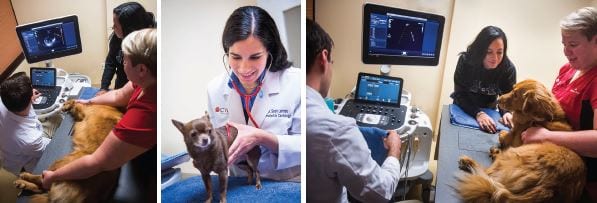The Role of a Board Certified Veterinary Cardiologist in Pet Emergency Care}
Wiki Article
What You Need to Learn About Veterinary Providers: A Review of Diagnostic Tools and Procedures
Veterinary solutions play an essential duty in preserving the health and wellness of animals. Normal examinations can expose concealed wellness concerns early on. Different diagnostic devices and procedures, such as blood examinations and imaging strategies, give crucial understandings into a pet's wellness. Comprehending these techniques is vital for animal owners. What particular analysis procedures are most commonly made use of, and exactly how can they impact a pet's therapy strategy?Relevance of Normal Vet Check-Ups
While several animal proprietors may undervalue the value of regular veterinary exams, these visits are necessary for maintaining a pet's general health. Regular brows through to the veterinarian permit for very early discovery of potential health and wellness issues before they escalate into major problems. Routine examinations usually consist of vaccinations, which are necessary for avoiding infectious illness that might seriously affect an animal's well-being. In addition, these appointments provide an opportunity for veterinarians to examine the animal's weight, dental health, and overall problem, making certain that the pet is thriving. During these visits, family pet owners can likewise receive important guidance on diet, exercise, and preventive care customized to their details animal's needs.Usual Diagnostic Treatments in Veterinary Medication
In vet medicine, precise diagnosis is vital for reliable therapy. Typical analysis treatments consist of blood screening techniques, progressed imaging technologies, and urinalysis, each playing a substantial function in determining health concerns. Recognizing these approaches enhances the capacity to supply suitable take care of pet clients.Blood Testing Strategies
Blood testing strategies act as important analysis tools in veterinary medication, enabling vets to examine the health of pets precisely. These strategies entail gathering blood samples to assess different parts, such as white and red blood cells, platelets, and biochemical markers. Common examinations include total blood counts (CBC), which review general wellness and detect infections, and biochemical panels, which assess body organ function and metabolic condition. In addition, serological examinations can determine specific conditions through antibody discovery. Blood screening is minimally intrusive and gives crucial details that helps in diagnosing problems, keeping an eye on health condition, and evaluating actions to therapies. Overall, these techniques play a vital function in making certain optimal take care of pet dogs and livestock alike.Imaging Technologies Made Use Of
Analysis imaging technologies are crucial devices in vet medicine, matching blood screening strategies by offering visual understandings right into a pet's internal structures. Typical imaging methods consist of X-rays, which serve for reviewing bone cracks and discovering international items, and ultrasound, which enables for real-time visualization of soft tissues and organs. Magnetic resonance imaging (MRI) uses detailed pictures of complex anatomical locations, particularly in neurological assessments. Computed tomography (CT) gives cross-sectional photos, boosting analysis accuracy for numerous problems. Each of these modern technologies help veterinarians in identifying diseases, intending treatments, and monitoring recuperation. By integrating imaging technologies, veterinary experts can much better assess an animal's health and make notified decisions regarding their care.
Urinalysis and Diagnostics
Urinalysis works as a vital diagnostic tool in veterinary medicine, offering valuable insights right into an animal's general health and assisting in the discovery of various problems. This non-invasive treatment analyzes urine samples to analyze kidney feature, hydration standing, and metabolic disorders. Usual components taken a look at consist of specific gravity, pH levels, glucose, healthy proteins, and the visibility of blood or germs. Unusual searchings for can indicate issues such as urinary system tract infections, diabetes mellitus, or kidney disease. To improve analysis precision, urinalysis is typically performed together with various other tests, such as blood work and imaging researches. Early detection via urinalysis can cause timely treatments, improving the prognosis for several vet clients. For that reason, it is a vital aspect of detailed veterinary care.Recognizing Blood Tests and Research Laboratory Evaluation
Comprehending blood tests and laboratory analysis is crucial in vet medicine as it helps in detecting different health conditions in animals. Various sorts of blood examinations offer vital info regarding a pet's inner state, while translating laboratory results calls for cautious factor to consider of numerous aspects. This area will certainly discover the kinds of blood examinations readily available and the significance of their outcomes.Kinds of Blood Tests
Blood tests play a crucial duty in veterinary medicine, supplying essential insights right into a pet's wellness condition. Different kinds of blood tests are utilized, each serving various objectives. Complete blood matters (CBC) examine total wellness and detect problems such as anemia or infection. Biochemical profiles examine organ function by determining enzymes and electrolytes, supplying insights right into metabolic wellness. Serological examinations recognize particular antibodies or pathogens, aiding in the diagnosis of infections or autoimmune diseases. Blood inputting warranties secure transfusions, while coagulation tests gauge the blood's capability to clot, crucial for surgeries. These examinations collectively improve medical diagnosis, therapy preparation, and monitoring of an animal's health and wellness, illustrating the value of detailed research laboratory evaluation in vet treatment.
Interpreting Lab Results
A complete analysis of lab results is vital for precise diagnosis and therapy in vet medication. Translating laboratory results calls for an understanding of regular recommendation ranges and the relevance of discrepancies. Blood tests can expose different health indications, such as organ feature, electrolyte equilibrium, and the visibility of infections. Veterinarians must take into consideration the whole scientific image, including the pet's history, health examination findings, and any kind of signs and symptoms presented. Variations in results might occur from factors such as age, type, and underlying health and wellness problems. As a result, laboratory outcomes need to not be watched alone but rather as part of a comprehensive diagnostic technique. Exact analysis permits tailored treatment plans and much better end results for vet clients.Imaging Techniques: X-rays, Ultrasounds, and Beyond
Imaging strategies are important tools in vet medication, offering essential understandings right into the health and health of animals. Among one of the most commonly used approaches are Ultrasounds and x-rays. X-rays are important for imagining bone structures, helping vets recognize fractures, lumps, or international objects. This approach is non-invasive and quick, making it excellent for urgent situations.Ultrasounds, on the various other hand, make use of acoustic waves to develop photos of soft cells and body organs. This strategy is specifically valuable for examining the heart, abdominal area, and reproductive organs, enabling veterinarians to analyze conditions like liquid buildup or organ abnormalities.Beyond X-rays and ultrasounds, advanced imaging methods such as computed tomography (CT) and magnetic vibration imaging (MRI) are progressively made use of in vet technique. These methods use detailed cross-sectional pictures, improving the accuracy of diagnoses and therapy strategies. Cancer Veterinary Near Me. Generally, imaging strategies play a vital function in ensuring efficient vet treatmentThe Role of Biopsies in Diagnosing Pet Health And Wellness Issues
Accuracy in detecting health concerns in family pets typically rests on using biopsies, which supply conclusive information regarding cells abnormalities. A biopsy involves the removal of a tiny sample of tissue for examination under a microscope, permitting veterinarians to determine various conditions, consisting of infections, lumps, and inflammatory conditions. This analysis tool is vital for distinguishing in between deadly and benign growths, assisting therapy choices, and evaluating the seriousness of a condition.Biopsies can be done utilizing numerous strategies, such as needle aspiration, incisional biopsies, or excisional biopsies, relying on the location and kind of cells entailed. The selection of technique might affect recovery time and the amount of tissue gathered. Inevitably, the information gleaned from a biopsy can bring about targeted treatments, boosting outcomes for pet dogs encountering severe health difficulties. Vets stress the value of this procedure in attaining accurate diagnoses and effective therapy plans.Advanced Diagnostic Tools: Endoscopy and CT Scans

Advanced diagnostic tools, such as endoscopy and CT scans, play an essential duty in modern-day vet medicine, using non-invasive approaches to envision internal structures and detect various problems in animals. Endoscopy entails using a flexible tube equipped with a cam, allowing vets to take a look at the intestinal tract and breathing system directly. This technique can disclose abnormalities such as growths, international bodies, or swelling, allowing targeted treatment plans.CT scans, on the various other hand, make use of sophisticated imaging innovation to create thorough cross-sectional pictures of the body (Board Certified Veterinary Cardiologist). This approach is especially useful for examining facility frameworks like the mind, back, and joints. By offering high-resolution pictures, CT scans help vets in identifying more tips here problems that may not appear with traditional radiography. With each other, these innovative tools improve diagnostic precision, boost therapy results, and inevitably contribute to far better general pet health and wellness management

Interpreting Test Outcomes: What Family Pet Owners Must Know
Comprehending test outcomes can be a challenging job for pet owners, specifically after innovative procedures like endoscopy and CT scans have actually been carried out. Analyzing these outcomes calls for a grasp of medical terms and a clear understanding of what the findings indicate about the animal's health. Vets typically supply explanations, yet the complexity of the outcomes can still lead to confusion.Pet owners ought to actively engage in discussions with their vets, asking concerns to clear up any uncertainties. It is vital to understand unusual versus typical outcomes and the implications for the pet dog's treatment strategy. In addition, recognizing that some results may need more screening or monitoring can help owners remain informed about their family pet's wellness journey. Ultimately, a collective strategy in between pet dog proprietors and veterinary experts fosters better wellness end results and enhances the overall care experience for animals.Frequently Asked Questions
Exactly how Do I Select the Right Veterinary Clinic for My Animal?
Selecting the ideal veterinary center entails looking into local choices, evaluating certifications, going to facilities, and analyzing staff interactions (Cancer Veterinary Near Me). Prioritizing referrals from trusted resources can aid ensure the very best treatment and setting for a pet dog's wellness requirementsWhat Should I Do if My Family Pet Refuses to Go to the Vet?
When a family pet declines to head to the vet, it's recommended click here to read to continue to be calm, use deals with or playthings to lure them, and consider scheduling a home visit if anxiousness continues. Perseverance and favorable support are crucial.Are There Telehealth Options for Vet Solutions?
Telehealth choices for vet solutions are significantly offered, permitting animal my site proprietors to seek advice from with vets from another location. These solutions allow conversations concerning wellness problems, advice on minor ailments, and follow-ups without needing to visit a clinic.
How Frequently Should My Family Pet Have Dental Check-Ups?
The regularity of dental exams for family pets normally depends upon their age and type. Usually, vets suggest annual dental analyses, although some pet dogs might need more frequent visits to keep excellent dental health and wellness.
What Are the Prices Related To Vet Diagnostics?
The costs related to vet diagnostics can differ widely, normally varying from basic tests like blood work to sophisticated imaging techniques. Aspects influencing costs include the facility's place, tools used, and particular tests required for every family pet. Vet solutions play an important role in maintaining the health of pet dogs. While many pet owners may take too lightly the importance of routine veterinary check-ups, these visits are crucial for preserving an animal's total wellness. In addition, these consultations give an opportunity for veterinarians to assess the animal's weight, oral health and wellness, and total problem, making certain that the pet dog is growing. Precision in detecting health problems in pet dogs typically hinges on the use of biopsies, which provide conclusive details regarding tissue abnormalities. Additionally, identifying that some outcomes might need additional testing or surveillance can assist proprietors remain notified about their pet's wellness journey.Report this wiki page